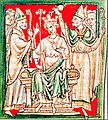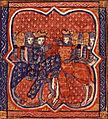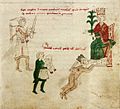Richard I of England facts for kids
Quick facts for kids Richard I |
|
|---|---|

Effigy (c. 1199) of Richard I at Fontevraud Abbey, Anjou
|
|
| King of England (more..) | |
| Reign | 3 September 1189 – 6 April 1199 |
| Coronation | 3 September 1189 |
| Predecessor | Henry II |
| Successor | John |
| Regent | |
| Born | 8 September 1157 Beaumont Palace, Oxford, England |
| Died | 6 April 1199 (aged 41) Châlus, Duchy of Aquitaine |
| Burial | Fontevraud Abbey, Anjou, France |
| Spouse | |
| Issue | Philip of Cognac (illegitimate) |
| House | Plantagenet–Angevin |
| Father | Henry II of England |
| Mother | Eleanor of Aquitaine |
| Military career | |
| Battles/wars | Third Crusade |
Richard I (8 September 1157 – 6 April 1199) was King of England from 1189 until his death in 1199. He also ruled as Duke of Normandy, Aquitaine and Gascony, Lord of Cyprus, and Count of Poitiers, Anjou, Maine, and Nantes, and was overlord of Brittany at various times during the same period. He was the third of five sons of King Henry II of England and Eleanor of Aquitaine and seemed unlikely to become king, but all his brothers except the youngest, John, predeceased their father. Richard is known as Richard Cœur de Lion (Norman French: Le quor de lion) or Richard the Lionheart because of his reputation as a great military leader and warrior. The troubadour Bertran de Born also called him Richard Oc-e-Non (Occitan for Yes and No), possibly from a reputation for terseness.
By the age of 16, Richard had taken command of his own army, putting down rebellions in Poitou against his father. Richard was an important Christian commander during the Third Crusade, leading the campaign after the departure of Philip II of France and achieving considerable victories against his Muslim counterpart, Saladin, although he finalised a peace treaty and ended the campaign without retaking Jerusalem.
Richard probably spoke both French and Occitan. He was born in England, where he spent his childhood; before becoming king, however, he lived most of his adult life in the Duchy of Aquitaine, in the southwest of France. Following his accession, he spent very little time, perhaps as little as six months, in England. Most of his life as king was spent on Crusade, in captivity, or actively defending his lands in France. Rather than regarding his kingdom as a responsibility requiring his presence as ruler, he has been perceived as preferring to use it merely as a source of revenue to support his armies. Nevertheless, he was seen as a pious hero by his subjects. He remains one of the few kings of England remembered more commonly by his epithet than his regnal number, and is an enduring iconic figure both in England and in France.
Images for kids
-
Geoffrey de Rancon's Château de Taillebourg, the castle Richard retreated to after Henry II's forces captured 60 knights and 400 archers who fought for Richard when Saintes was captured.
-
Richard I in profile, funerary effigy above the tomb containing his heart in Rouen Cathedral (early 13th century)
-
Richard I being anointed during his coronation in Westminster Abbey, from a 13th-century chronicle
-
Richard and Philip of France, French manuscript of 1261. Bibliothèque Nationale de France.
-
Depiction of Richard (left) and Saladin (right), c. 1250–60, on tiles found at Chertsey Abbey in Surrey.
-
Depiction of Richard being pardoned by Emperor Henry VI in Peter of Eboli's Liber ad honorem Augusti, c. 1196
-
Ruins of Dürnstein Castle, now in Austria, where Richard was at first kept captive
-
The ruins of Château Gaillard in Normandy
-
Richard affiancing Robin Hood and Maid Marian on a plaque outside Nottingham Castle
See also
 In Spanish: Ricardo I de Inglaterra para niños
In Spanish: Ricardo I de Inglaterra para niños














